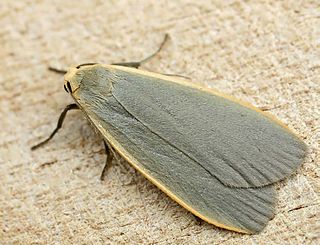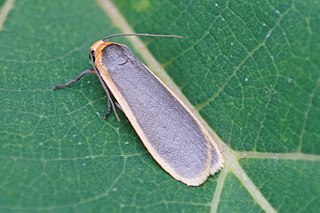
The Russian Far East is a region in Northeast Asia. It is the easternmost part of Russia and the Asian continent; and is administered as a part of the Far Eastern Federal District, which is located between Lake Baikal in eastern Siberia and the Pacific Ocean. The area's largest city is Khabarovsk, followed by Vladivostok. The region shares land borders with the countries of Mongolia, China, and North Korea to its south, as well as maritime boundaries with Japan to its southeast, and with the United States along the Bering Strait to its northeast.
Collita is a genus of moths in the family Erebidae. The genus was erected by Frederic Moore in 1878.

Eilema is a genus of moths in the subfamily Arctiinae. The genus was erected by Jacob Hübner in 1819.

Katha depressa, the buff footman, is a moth of the family Erebidae found in Asia and Europe. It was first described by Eugenius Johann Christoph Esper in 1787.

Collita griseola, the dingy footman, is a moth of the family Erebidae. The species was first described by Jacob Hübner in 1803. It is found in Europe and North and South-East Asia.

Wittia sororcula, the orange footman, is a moth of the family Erebidae. The species was first described by Johann Siegfried Hufnagel in 1766. It is found in Europe, Anatolia and further east across the Palearctic to southern Siberia and the Amur basin to China.

Eilema caniola, the hoary footman, is a moth of the family Erebidae. The species was first described by Jacob Hübner in 1808.

Tetheella is a monotypic moth genus in the family Drepanidae described by Werny in 1966. Its single species, Tetheella fluctuosa, the satin lutestring, was described by Jacob Hübner in 1803. It is found from western Europe across the Palearctic to Kamchatka, Sakhalin Island, Korea and Japan.
Dolgoma cribrata is a moth of the family Erebidae first described by Otto Staudinger in 1887. It is found in eastern Asia, more specifically Russia, China, Korea and Japan.
Collita coreana is a moth of the family Erebidae. It is found in Korea. Records for the Russian Far East and Japan are probably based on misidentifications of Manulea ussurica.
Collita gina is a moth of the family Erebidae. It is found in Japan.
Collita okanoi is a moth of the family Erebidae. It is found on the southern Kuriles and in Japan.
Collita digna is a moth of the family Erebidae. It is found in the Russian Far East.
Collita chinensis is a moth of the family Erebidae. It is found in Mongolia and China.
Manulea flavociliata is a moth of the family Erebidae. It is found in north-eastern Kazakhstan, southern Siberia, the Russian Far East, Mongolia, China and Korea.
Manulea minor is a moth of the family Erebidae. It is found in the Russian Far East and Japan.
Manulea affineola is a moth of the family Erebidae. It is found in the Russian Far East (Primorye), Korea, China (Shaanxi) and Japan.

Manulea japonica is a moth of the family Erebidae. It is found on the Kuril Islands (Kunashir) and in China, Korea and Japan. It has a wingspan of 25–30 mm.
Manulea nankingica is a moth of the family Erebidae first described by Franz Daniel in 1954. It is found in the Russian Far East (Primorye), China (Jiangsu), Korea and Japan.
Manulea ussurica is a moth of the family Erebidae. It is found in the Russian Far East (Primorye), China and Korea.







